My extremely brief NAVAL CAREER
OK, I only did my year of national service in the South African Navy in 1970, but there are some aspects that you may find interesting. These photos were taken on slide film on a very basic little camera. Some of the slides had a little mould on before being copied.
When I look back on this I think of Spike Milligan's book, Adolf Hitler, My Part in his Downfall. As with Spike, my role in defending the southern oceans was little more than play posturing on the part of South Africa. This was 1970. Our navy was minuscule. It had inherited some old boats from the Royal Navy and they used Simonstown as a refueling stop. We had ordered some small French submarines and our new state-of-the-art mainly underground Maritime Headquarters had begun at Silvermine. But what I was involved in was more posturing than strength. The Russian threat was very evident aroound our coast and even within the country.
Egged on by my mother, I had investigated the option of naval architecture as a career. I had very little experience of boats and ships really, but it looked interesting. IF I had managed to become an officer in the navy there could have been financial support for such a course at Stellenbosch University. Anyway I did not get that far and I entered a standard architectural course at UPE instead.
But overall this navy experience did me a lot of good and I am very pleased to have been part of it.
Gordon's Bay on False Bay looked like a sleepy coastal resort in 1970. I did my basic training at the Gordons Bay naval base there that year. Our training “ship” was a converted wooden fishing boat and we rowed or sailed whalers. (Sort of makes “basic training” really basic). Guard duty at night could be intriguing with occasional marine fluorescence in the lapping water, disturbed cormorants or skimmed stones.
We joined with other bases for a sports day. I did reasonably well in the walking race. Now that means walking at speed with every step heel first. Try it. It is not as easy as it sounds and can be excruciating.
We worked on the local sports field. Cheap labour to while away the hours. We dug a trence, in theory to form a drainage system on the flat ground. Then it was off to the Strand beach to load up the large old Bedford truck. with sand. Our coloured driver would search the shoreline and once found an octopus, which he killed, cleand and turned inside out. Then it was off to the sports field to uload our sand. As the truck was backing towards the trench I lifted the heavy back flap over the mound of excavated earth and slipped in under the wheels. At that very second the truck stalled and I got out shaken, but unscathed!
I didn't make the grade for an officer course, but did meet some interesting guys such as a descendent of Messerschmitt and Prime Minister Vorster's son (who had got into the officer course).
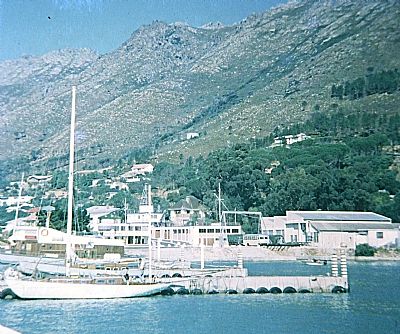
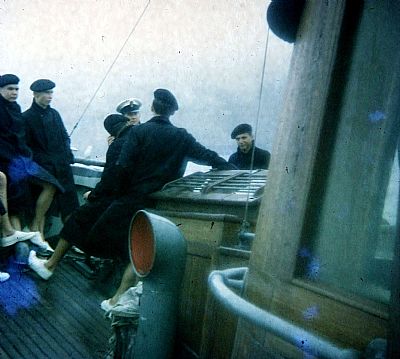
Our initial sea experience was on this converted fishing boat. You can just make it out in the preceding picture - beyond the yacht. Everyone felt at least a bit queasy, some more than others. The uniform for ratings during regular activities was rather basic and included shorts, blue shirt, tackies, beret and a Burberry coat.
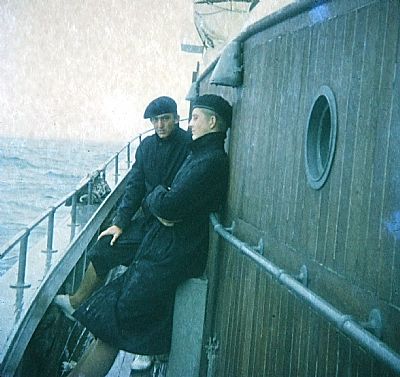
Note the timber construction of the converted fishing boat. This was also used for smaller bespoke naval vessels during WWII as timber did not show up as readily on enemy radar.
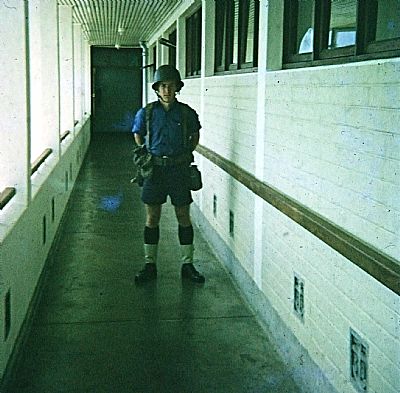
This is me during an introductory marines course. In 1970 SA did not have a marine devision and this short basic exercise seemed to be a trial run of some kind. We did little other than get dressed up like this. But we looked intimidating ?!? This was taken on the corridor balcony adjoining our dormitory.
Physical training could include rowing the wooden clinker whalers, fixed seat, boats of some vintage and based on the attendant whaling boats. Quite fun although exhausting out on the bay. Recreation could include hoisting a sail on those same boats. I was not good at that, but it was a good experience.
The following are general views of the Gordon's Bay Naval Base and of the town.
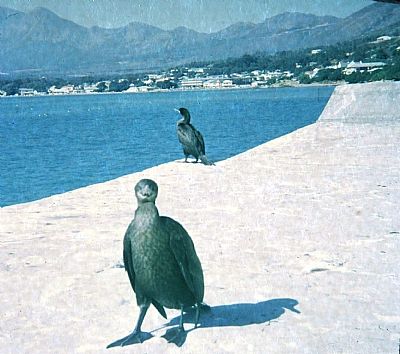
Spare time was often spent on the wharf with the spectacular views across Gordon's Bay, itself part of False Bay. Beyond are the Hottentots Holland Mountains with the Steenbras Dam hidden above them. Cormorants happily joined us.
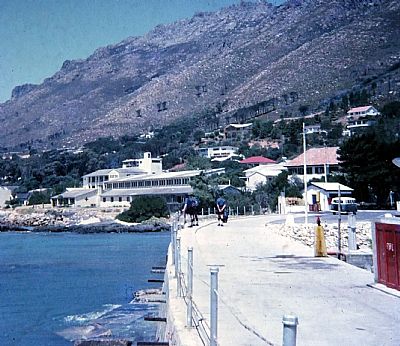
The long building is the dorm. Admin, service buildings to the right.
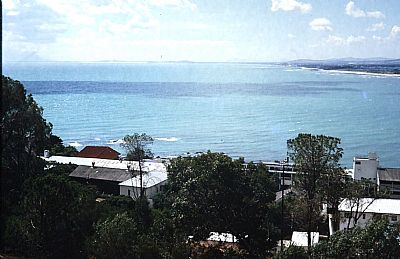
Punishment could be a run up the mountainside to the rocks painted white and forming "GB". I never had to do that, but did go up one day just beyond the houses and enjoyed this view. It looks almost Mediterranean. That is the naval base below.
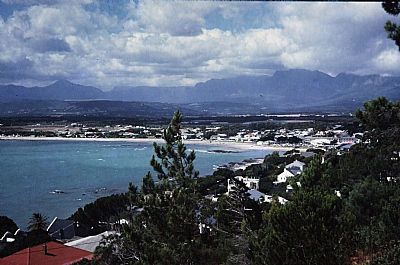
The bay with its white sands stretches around towards The Strand.
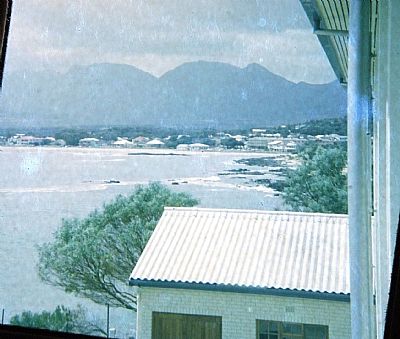
A view from the dorm open corridor.
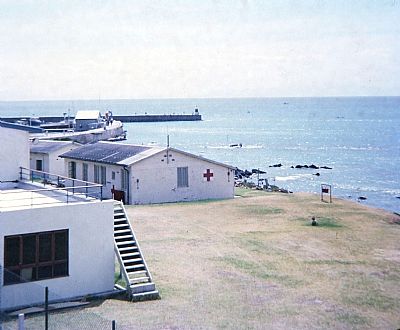
And in the other direction towards the little harbour.
Our Basic Training included such things as warnings about venereal disease (even after the dad of someone objected, movies from old war documentaries, seamanship, knots, first aid and an awful lot of marching. And some shooting practice. I was excused marching when I developed a serious reaction to the vaccine (having never had one before this) and so sat out watching from the sidelines for some of it. It was during this Basic Training that we were taught how to use rifles. We went off to a rifle range and lay on the terraces peering at paper targets way down the other end. We had been warned that sometimes the rounds would just go off and that happened to me. 20 rounds at one go. Not a time to panic. Deafening for the ears even with basic protection.
The targets were pinned to boards held up on poles from behind a concrete and earth rampart. Then it was my turn to hold the target while equally inexperienced colleagues shot at them. It is a little safer than it sounds as we were down in a sort of bunker, the concrete and earth rampart above us. But it was still scary as splinters of wood and some pins and nails screamed around us.
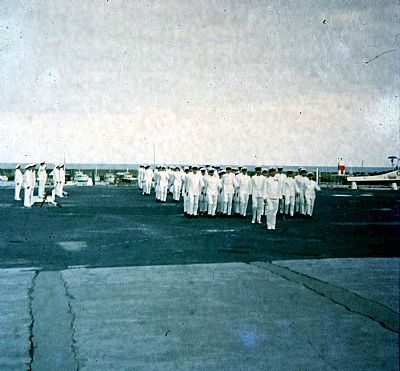
Here we are (me on the sidelines) in our ice cream suits drilling away. You can see the top of our "ship" berthed in the background. (No rifles on this occassion).
Gordon's Bay was not that far from Kuilsrivier and my aunt and uncle's wine farm Zevenfonteirn (seven fountains / springs). That was to later be bought and merged with the neighbouring farm Onverwacht (unexpected) and became Zevenwacht. An upmarket events venue. But that was still in the future when I made my way there during breaks in Basic Training.
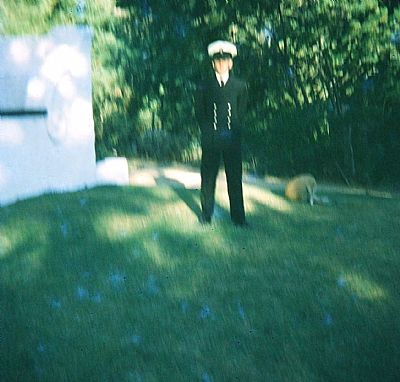
A poor quality photo, but it shows me on the front lawn of Zevenfontein.
I then did a radar course on the Bluff in Durban before being posted to a ship. The radar training facilities were little changed since WWII and from below the Bluff drifted the smell of whales being butchered from the still active whaling station.
Looking smarter. The South African Navy uniform while in public is a black suit and a peaked cap. Officers differ mainly in their cap badges and insignia. This picture was taken on the verandah of a flat while visiting my father's aunt in Durban. I walked for miles including through the Durban Docks and remember seeing antelope being hoisted onto a ship with very basic crates with a crane; their heads clearly visible.
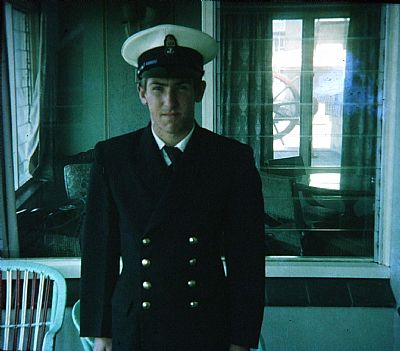
When I finished this radar course I was sent, again by train, home for a short break and from there to my ship.
My ship was the SAS Simon van der Stel (named after the last Commander and first Governor of the Cape Colony, the Dutch settlement at the Cape of Good Hope). This destroyer had a permanent small list to port, but somehow managed to go through the swells (rather than over them) such as off Cape Point. We would be ordered in advance to batten down the portholes. Green water could be seen outside sometimes.
If really rough weather was anticipated we would need to batten down the deadlights over them as well. We, at least most of the ratings, slept in hammocks strung from the deckhead (ceiling). When told we could use “stretchers” these turned out to simply be bits of wood found on the quayside that could keep the ends of the hammock wider so we would not be encased in canvas cocoons. We would need to roll and tie up our hammocks every morning – the theory being that they could act as lift belts as they were presumed to float.
I don't have many pictures of SAS Simon v d Stel and those that I do were again taken with my very basic camera.
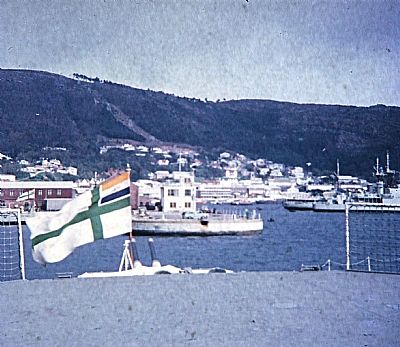
This one was taken across the helicopter pad towards Simons Town.
Compare this to the picture below when it was HMS Whelp 1944. My picture aren't of much help for comparison, but the main difference is the addition of the helicopter deck.
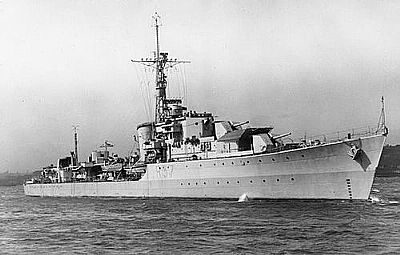
HMS Whelp 1944 [Wiki].
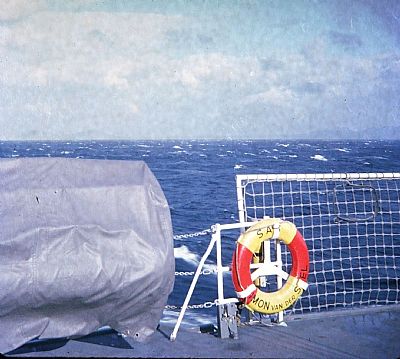
We spent a lot of time just sitting around at sea while not on duty. The helicopter deck was a favourite hangout. But it could be windy and cold. The captain would get us checked on regularly to ensure we hadn't gone overboard.
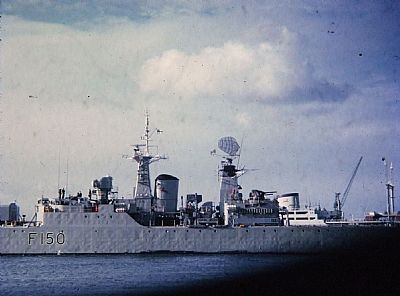
Our destroyer was quite tiny compared to this one. I can't remember its name, but it is large by comparison. It is also a SAN ship.
Of note in some of my picture is the South African flag of the time. I peeled many a potato down below. The milk would arrive in large urns which we would store in the disused mortar launcher on deck. I had an occasional very brief turn at steering the ship, but my real role was to be on radar duty or plotting the ship's course on backlit map. Some excitement occurred when the radar picked up thousands of sardines splattered by an anti-submarine depth charge set off in a practice exercise. A “high tech” illuminated compass rose automatically followed the ship's course across the chart, but we had to add the details – with chinagraph pencils on the polycarbonate overlay. [This was way before GPS so the automated tracking was purely based on speed, time of travel and degrees]. Decca Navigation System stations had been set up along the coast and were used to confirm location, accuracy being through triangulation.
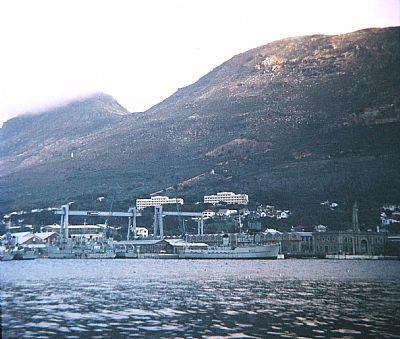
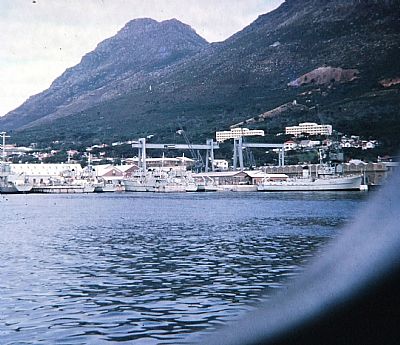
Two views of Simonstown docks through the porthole of our ship.
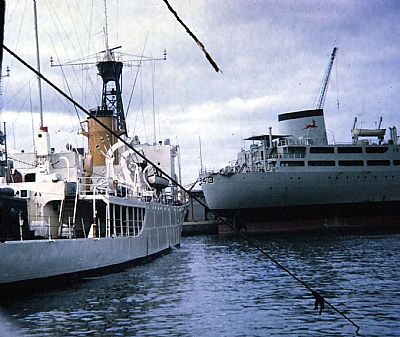
Simonstown docks with SAS Protea to the left, a survey ship; and SAS Tafelberg, a supply ship to the right.
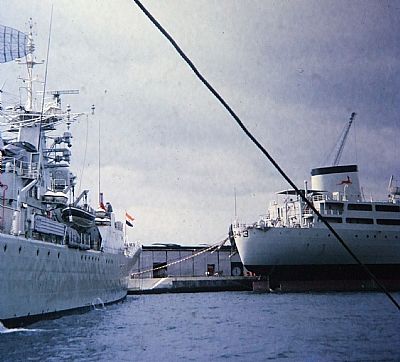
Almost the same scene, but the Protea is off and its place has been taken by a visiting RN ship. Some of us went on board. Really fun as the RN ratings all thought we were officers due to our peaked hats. They of course wear the tradtional round peak-less caps unless of rank.

Simonstown Station. The railway passes very close to the sea. You can see seansand that has blown over the barrier. The hills and some interesting houses rise up to the right.
Some of us went in to Cape Town on the train. The Seaman's Institute had cheap drink, but I found it grubby.
I had been assigned to the President's guard, I think for the opening of parliament. This was not his personal guard, but rather the naval conscripts and others needed to decorate the road on the way. We practiced in our ice cream suits with rifles. But that was not to be for me as I got asthma.
I wasn't on the ship long due to asthma triggered by the fumes. I was offered demobilisation, but chose to stay on and I spent my remaining months in Maritime Headquarters at Youngsfield, a remnant of a WWII airfield.
These were the days of apartheid and paranoia about Russian or any communist influence and possible incursions. At the headquarters we used the high tech system of plotting both friendly and Russian or other communist country shipping around the Cape with paper labels on pins in a map on the wall. The reports would come in regularly from spotter planes and there really were lots of suspicious cargo ships carrying military vehicles such as trucks and tanks, on board clearly visible in the photos sent back.
The new state-of-the-art Maritime Headquarters was then only being started at Silvermine in the hills above the Cape Flats. (There were stories in later years how it had been ransacked, the fences for instance being stolen).
Youngsfield was a combination of camps for the army, airforce and the navy. We pretty much kept aloof from the others. Sometimes we saw airforce activity such as a Dakota plane coming in to land on the grass airstrip. Such a chubby looking plane, but amazingly agile in the air.
Besides plotting Russian ships on a wall map, we operated the phones between different naval departments. This was an antique plug board system even then, presumably retained until the new Maritime HQ was completed. It could get hot in there and the headsets shocked us as moisture got into their electrics.
This base was not that far from Rondebosch and I even walked there sometimes to see my Watson cousins.
I once got "court-martialled" for swapping night duties with a friend without official approval. We both got gated the following due days off.
In the next section of the building were radio operators. Due to the humidity within the building. For some reason they had full air conditioning, while we just had small vents off it . We would often get dagga (cannibis) drifting through the system. I found dagga growing outside the dormitory building. And stored under the floorboards.
More of a problem was drunken behaviour amongst the conscripts. A sort of putrid nartjie (like an easy-peeler orange) a;chohol was being brewed in the dorm ceiling with a bottle for fermentation and a condom as a means of containing the expanding furmes.... until it burst.

Youngsfield is a vast extremely flat fenced area, but it could look nice when the flowers were in bloom.

White stones marked the different areas and internal roads.

The barrack still had a sort of WWII atmosphere about them. I think these were airforce.
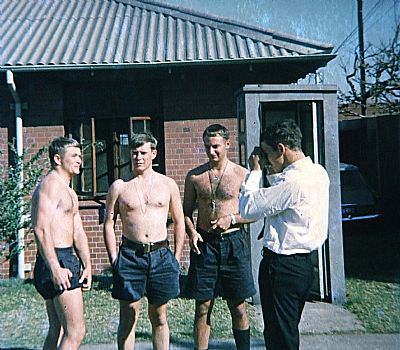
One of our group had an emergency at home in East London so the Navy arranged for him to be flown back in a Harvard. He needed to be in his suit. The rest of us, well, were as scruffy as ever while off duty. (Also note the phone box and the asbestos roof).

It could be a bit boisterous in the dormitory when not on duty.
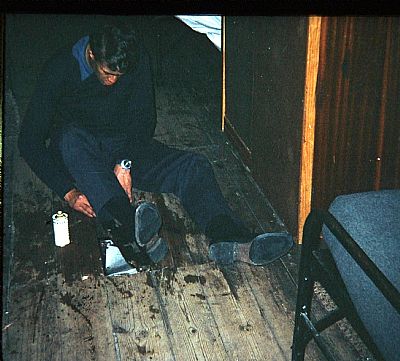
The fermenting nartjie wine in the ceiling was taken down a duly burst. I cannot remember why there was a polish bottle in this picture, I think it was to disguise the smell.
As noted above, SAS Simon van der Stel had a previous life – as HMS Whelp. When I was on her she looked rather tired and out of date in spite of a recent addition of a helicopter deck.
HMS Whelp was one of eight W-class destroyers built for the Royal Navy during the Second World War. Completed in 1944, the ship spent most of the war assigned to the Eastern and Pacific Fleets. She screened British aircraft carriers as their aircraft attacked targets in the Japanese-occupied Nicobar Islands and Dutch East Indies, Formosa and near Okinawa. Whelp was present at the Japanese surrender in Tokyo Bay in 1945 and later in Hong Kong. She was paid off in January 1946 and went into reserve. Whelp was sold to the South African Navy (SAN) in 1952 and renamed Simon van der Stel. She was subsequently converted into a fast anti-submarine frigate in the early 1960s and served as a training ship from 1968 until 1972 when she went back into reserve. Simon van der Stel was recommissioned in 1975 for a refit, but that proved to be uneconomical and she was scrapped the following year. [Wiki]. I understand that she now sits on the bottom of False bay along with her sister ship SAS Jan van Riebeeck – part of an artificial reef to attract sea life. During her active service, her captain and first lieutenant were Commander G. A. F. Norfolk and Lieutenant Phillip Mountbatten (later Prince Philip, Duke of Edinburgh), respectively. So there you have it. I served on the same ship as Prince Phillip!
A recruit, even a conscripted one remains on potential call up for most of the rest of his life. I only attended two "refresher" events after that first year, both while I was at university.
The first involved a day out in Algoa Bay off Port Elizabeth in the failry small patrol boat with the commander and his two young children. A pleasant way to spend a Saturday. The kids spent most of the time under the table having become terrified of the shooting. The shooting was done by those who had done the shooting course. I, having done the radar course had little to do.
We bobbed about. The oil drum bobbed about. After many tries, it was eventually hit and sunk. Even on a realatively calm ocean as that day, it is surprisingly difficult to hit something from a small boat with the swells tipping the gun angle this way and that; the target which was not very big, disappearing from view every few seconds. This was practice shooting at sea on a small scale. At least from a larger ship the line of view is downwards and the target is less likely to disappear from view.
The second event was a harbour protection exercise. I had tried to get out of it as it was soon before exams, but could not. So there I was with a number of others patrolling the docks looking for the "enemy". What a waste of time. Most of that was along the dockside itself. I then had to stand on the roof and report on anything suspicious seen from there. Also boring. Until we saw the diving crew return from inspecting the underside of ships in the docks. They brought ashore someone who had drowned. He had evidently had trouble while under a ship.
Aircraft
You may have got the impression from my descriptions of the South African Navy that it was somewhat behind the times and using old equipment. The modern Maritime Headquarters was being built at Silvermine to replace that at Youngsfield where I had been stationed and some submarines were awaited from France. So upgrades were in motion.
My ship Simon van der Stel, and others though were hand-me-downs from the RN after WWII. Similarly some of the aircraft around were still post-WWII. By this time the airforce did have new Mirages, Buccaneers etc, but others still in service were what today are considered historical.
These included 3 types that I saw both while in the navy and afterwards.
When I was at Maritime Headquarters in Youngsfield the main surveillance plane aloing the coast was the Catalina. These were flying boats based in Durban and St Lucia. I only had a glimpse of one once, but we used to plot the information that they sent back to us of Russian ships and commercial ships with Russian military cargoes.

They had been used during WWII to spot German U-boats along the coast.
While at Youngsfield I saw a Dakota take off from the grassed airfield close by. More specifically known as the Douglas C-47 Skytrain, this is a military transport aircraft that played a crucial role during World War II. Although not that large compared to more modern troop and cargo carrier planes, they look somewhat chubby and clumsy on the ground. This one took off with deep rumbling effort, but soon exhibited manoeuvrability and grace once airborne.

This had been a very successful long serving plane. An announcement from as lates as 2023 ended its service. After 81 years of military service in South Africa, the C-47 Dakota is finally being withdrawn from the South African Air Force (SAAF). Air Force Base Ysterplaat-based 35 Squadron, which operates the type, was this week told that the aircraft will be phased out. [ defenceweb.co.za].
Harvards
The Harvard, officially known as the North American T-6 Texan, is a historic advanced trainer aircraft used extensively during World War II for pilot training. We used to see and hear them over the Cape Flats. There was also a small squadron based in Port Elizabeth while I was at university. We used to hear them way before seeing them - a deep loud agonising droning metalic wail.
It was in one of these that the guy shown in a photo above was given a ride back to East London to see his injured sister.

The SAAF operated a large number of Harvards from 1940 until their retiremnt on Friday 17 November 1995. The type had been in service for 55 years and to celebrate the retirement 55 harvards flew a last flypast at Air Force Base Langebaanweg on Friday 17 November 1995. [theharvard.co.za/the-saaf]
These three planes are what you may see today at airshows or in museums. In retrospect they seem to give me a tangible link with an earlier post-war era.

